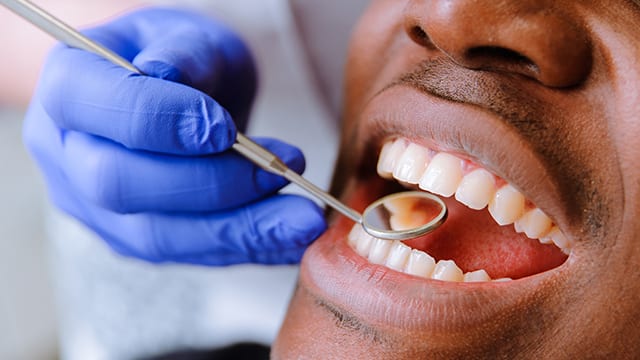1. Mirrors
A dental mirror is the single most important professional dental tool for both dentists and dental hygienists. Without this tool, it would be challenging to examine the surfaces of your teeth or the gum tissue at the back of the mouth. Mirrors can be made of metal or fiberglass frames with high-tech surfaces such as a rhodium-plated mirror to avoid image distortion.
By reflecting the light from above, dental mirrors help illuminate your mouth's interior, enabling the dental hygienist to identify calculus deposits more easily. Some mirrors have a concave shape that offers magnification capabilities to help the dental hygienist spot even the smallest deposits.
Handles are typically made out of a stainless steel material or some out of a resin material. While some mirrors are reusable, others are lightweight and disposable for easier manipulation and reduced wrist fatigue.
2. Scalers
Scalers are hand-held metal teeth cleaning tools that scrape off the plaque and calculus (tartar) from the teeth. The pointed end is used for the tooth section above the gumline, while the curved blunt end is used to reach below the gumline without injuring the gum tissue.
Most dental hygienists usually begin with an ultrasonic scaler, which helps remove plaque and tartar while using a water spray to cool the instrument's tip and rinse the mouth. According to RDH Magazine, these come in two models called magnetostrictive and piezoelectric versions, which have different frequencies and tip movements but have been shown to deliver almost identical clinical results. The scaler hand instruments are used next to remove any plaque and tartar that remains on the teeth.
Your dental hygienist may choose not to use magnetostrictive ultrasonic scalers with patients who have cardiac pacemakers implanted because they can cause interference with the pacemaker, according to the American Dental Association (ADA).
3. Polishers
After the dental hygienist has removed the plaque and tartar from your teeth, the next step is polishing each tooth to ensure it's as white and shiny as possible. The most commonly used polishers are prophy angles, small rubber cups fitted to a low-speed rotary electric polishing tool. With a mild to moderate abrasive paste, these buff away uneven areas on the teeth leaving the entire surface smooth and clean. This makes it easier for healthy gum tissue to attach to the tooth surface. Polishing is completed after ultrasonic scaling and hand scaling.
4. Begin With a Rinse
Regardless of the teeth cleaning tools your dental hygienist uses, a professional cleaning will usually begin with a pre-procedural rinse. This improves the safety of the procedure for both the dental hygienist and patient.
Next time you see the tray of instruments your dental hygienist intends to use, you'll be able to identify the scalers, mirrors, and polishers. And you'll know that those tools will clean your teeth and prevent oral health conditions like gingivitis and tooth decay. And feel empowered to ask your dental hygienist for more information about their instruments.
Oral Care Center articles are reviewed by an oral health medical professional. This information is for educational purposes only. This content is not intended to be a substitute for professional medical advice, diagnosis or treatment. Always seek the advice of your dentist, physician or other qualified healthcare provider.
ORAL HEALTH QUIZ
What's behind your smile?
Take our Oral Health assessment to get the most from your oral care routine
ORAL HEALTH QUIZ
What's behind your smile?
Take our Oral Health assessment to get the most from your oral care routine
Join Us
Get the best of your oral health routine and take it to the next level with expert advice, recommendations, products and solutions and special offers.
Join Us
Get the best of your oral health routine and take it to the next level with expert advice, recommendations, products and solutions and special offers.















